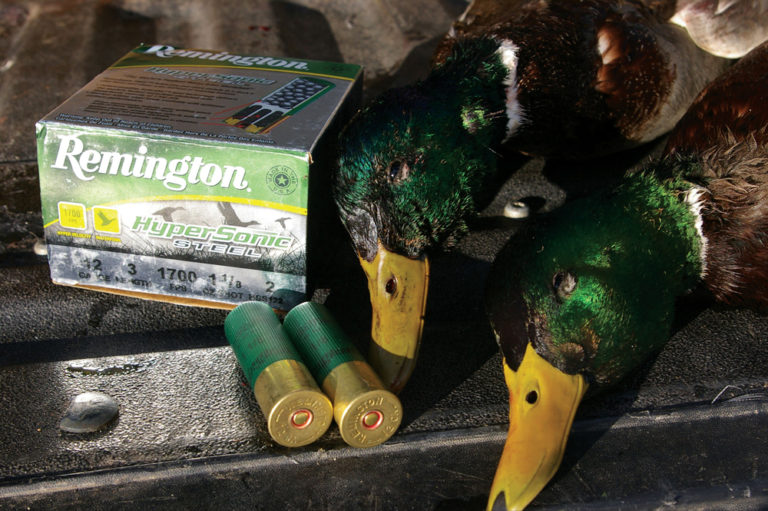
For waterfowlers seeking the ultimate in hard-hitting steel shot, these 3 new high performance steel loads are hard to beat.
Remington Hypersonic
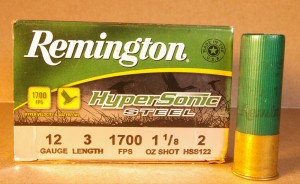
The initial problem with increasing the velocity of steel shot has been overcoming the shot charge’s inertia while not exceeding the shotshell’s relatively low pressure limit. Remington ammunition engineers determined if the acceleration resistance of the shot charge and wad could be overcome by gases from a small measure of powder, then once the shot was moving a second heavier amount of powder would substantially increase maximum velocity, while staying within pressure limits. After several attempts, the engineers tried an ignition chamber in the rear of a wad and called it the Xelerator.
“We actually drew the idea on a napkin,” said David Schluckebier, manager of new ammunition product development for Remington. When the primer ignites the powder in the ignition chamber, the powder gases start the wad and shot moving forward. The walls of the chamber are scored in three places so the wall ruptures and allows the flame to then ignite the main powder charge.
Remington states the HyperSonic ignition system fires various 10- and 20-gauge steel loads at 1,600 fps and 12-gauge loads at 1,700 fps. Velocities of 12-gauge loads I recorded were actually slightly faster. The 3-inch load of 1 1/4 oz. of No. 1s had a velocity of 1,789 fps five feet in front of the muzzle of a 28-inch barrel of a Benelli Nova pump. The 3½-inch load of 1 3/8 oz. of BBs had a velocity of 1,731 fps.

One drawback to launching relatively lightweight steel shot that fast is it flares more due to increased air resistance.
“We took that into consideration,” Schluckebier said, “and designed the shotcup on the Xelerator wad to tighten up patterns by keeping the shot charge together inside the cup a few feet past the muzzle before the shot is released into the air.” That is achieved with thin plastic that connects the shotcup’s four petals and delays them from flaring. When the petals do start to fan out, notches, called Wad Stress Concentrators, at the base of the shotcup increase petal spread to peal the wad away from the shot.
Patterns shot through the Nova with the 3-inch shells firing 1 1/4 oz. of No. 1s kept 74 percent of the pellets in a 30-inch pattern circle at 40 yards fired through full, modified and improved cylinder screw-in chokes. The 3 1/2-inch load of 13/8 oz. of BBs shot 75 percent of its pellets into a pattern circle through an improved cylinder choke, 64 percent shot through a modified choke and 62 percent through a full choke.
Federal Black Cloud
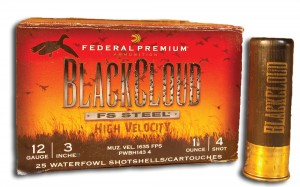
Federal’s Black Cloud FliteStopper (FS) steel shot and FliteControl wad give a new meaning to the term dead duck.
FS steel shot incorporates a belt around the pellets that acts as a cutting edge to enlarge wound channels in birds. The diameter of FS No. 2 steel pellets at their belt measure .17 of an inch in diameter, which is nearly the width of BB pellets. Most Black Cloud loads include 40 percent FS pellets and 60 percent regular steel pellets. Black Cloud Close Range loads contain all FS pellets.
These steel pellets are held in a FliteControl wad with six small petals at the base and three larger petals part way up the wad that open relatively slowly to start backing the wad away from the shot roughly 10 yards from the muzzle. That results in very tight patterns.
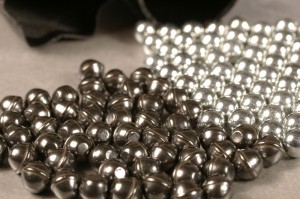
Before testing the loads on a pattern board, I wondered if the belt on the FS pellets would cause them to flare due to increased air resistance. My tests revealed that wasn’t the case. The FS pellets cut holes in the paper like the tip of a knife (compared to the round holes of the regular steel pellets), and most were within the pattern circle. Black Cloud 12-gauge, 3-inch loads of 1 1/4 oz. of No. 2s shot through full, modified and improved cylinder chokes in a Beretta Model 3901 printed 80 to 83 percent of the load’s pellets in a 30-inch circle at 40 yards.
The velocity of Black Cloud loads is pretty fast, too. Ten-gauge loads of 1 5/8 oz. of shot have a velocity of 1,375 fps, 12-gauge 3.5-inch loads of 1 1/2 oz. of shot 1,500 fps and 3-inch 1 1/4 oz. a velocity of 1,450 fps. High Velocity 12-gauge 3-inch loads fire 1 1/8 oz. of shot at 1,635 fps.
Winchester Ammunition Blind Side

Shotgun authorities have preached forever that hard, round shot is required for tight patterns. But here comes Winchester saying its six-sided Blind Side Hex Shot patterns tightly, even though the pellets look like little bricks. Winchester achieves those tight patterns with its Diamond Cut Wad that keeps the shot inside a shotcup several feet past the muzzle before three petals near the base of the wad slowly deploy to pull the wad away from the shot.
Patterns tightened up with increased choke constriction when I patterned Winchester’s Elite Blind Side 12-gauge 3-inch load of 1 3/8 oz. of No. 2s. Patterns at 40 yards were 57 percent shot through an improved cylinder, 62 percent from a modified and 75 percent shot through a full choke.

Blind Side shells are loaded with slightly heavier amounts of shot than comparable HyperSonic and Black Cloud shells. Still, velocities are quite high at 1,400 fps for 1 1/4 oz. of Hex Shot in 12-gauge 2 3/4-inch shells, 1 3/8 oz. of shot in 3-inch shells and 1 5/8 oz. shot in 3.5-inch shells.
Winchester claims Hex Shot hits waterfowl like “high-velocity tumbling bricks, delivering massive wound channels that maximize energy deposit and knock-down shock within the bird.” My son and his friend took it upon themselves to determine if that was true by shooting the 12-gauge 3-inch load of 1 3/8 oz. of 2s while jump shooting mallards and Canada geese along a big river near our home. Thomas and his friend returned with nine ducks and six geese. They reported shooting out to 35 yards and only a couple of the geese required a follow-up shot to knock them down dead.
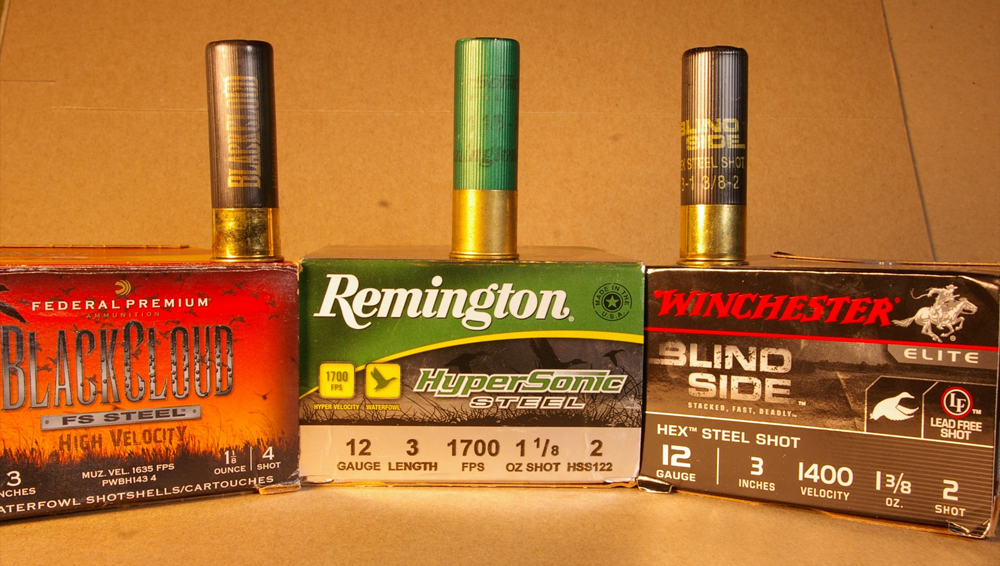
The Best Steel Loads for Ducks?
Thomas and I went duck hunting this past December to further study the situation. We alternated shooting 12-gauge Federal Black Cloud High Velocity 3-inch loads with 1 1/8 oz. of FS No. 4s shot at 1,635 fps, Remington HyperSonic 1 1/8 oz. of No. 2s at 1,700 fps and Winchester Blind Side 1 3/8 oz. of No. 2s at 1,400 fps.
We jump shot a slough and a creek. Thomas passed a couple chances at 50 yards on wild flushing birds because he knows any shot, no matter what its initial velocity or makeup, has fairly well spent itself at that distance. Plus, hitting a duck at that distance is a gamble. Our shots ranged from 20 to 30 yards, with a few at 40. After the shooting was finished and the feathers had settled, all the mallards had been killed with one shot, except one. That greenhead fell with a broken wing and required another shot.
“So which of the three loads shot the best?” I asked my son in my most analytical tone.
“Sneak into certain range, pick out one duck from the flock,” Thomas replied, “and all three loads are the best. Every one did its job.”
This article appeared in the February 11, 2013 issue of Gun Digest the Magazine.

Next Step: Get your FREE Printable Target Pack
Enhance your shooting precision with our 62 MOA Targets, perfect for rifles and handguns. Crafted in collaboration with Storm Tactical for accuracy and versatility.
Subscribe to the Gun Digest email newsletter and get your downloadable target pack sent straight to your inbox. Stay updated with the latest firearms info in the industry.

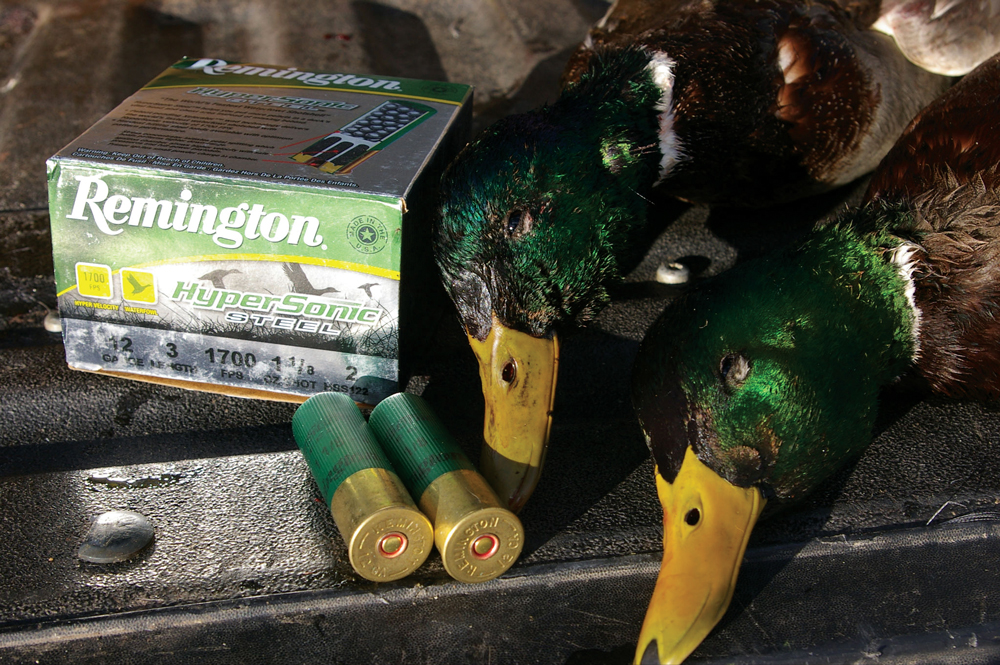
![Best Concealed Carry Guns In 2024 [Field Tested] Wilson Combat EDC X9S 1](https://gundigest.com/wp-content/uploads/Wilson-Combat-EDC-X9S-1-324x160.jpg)




